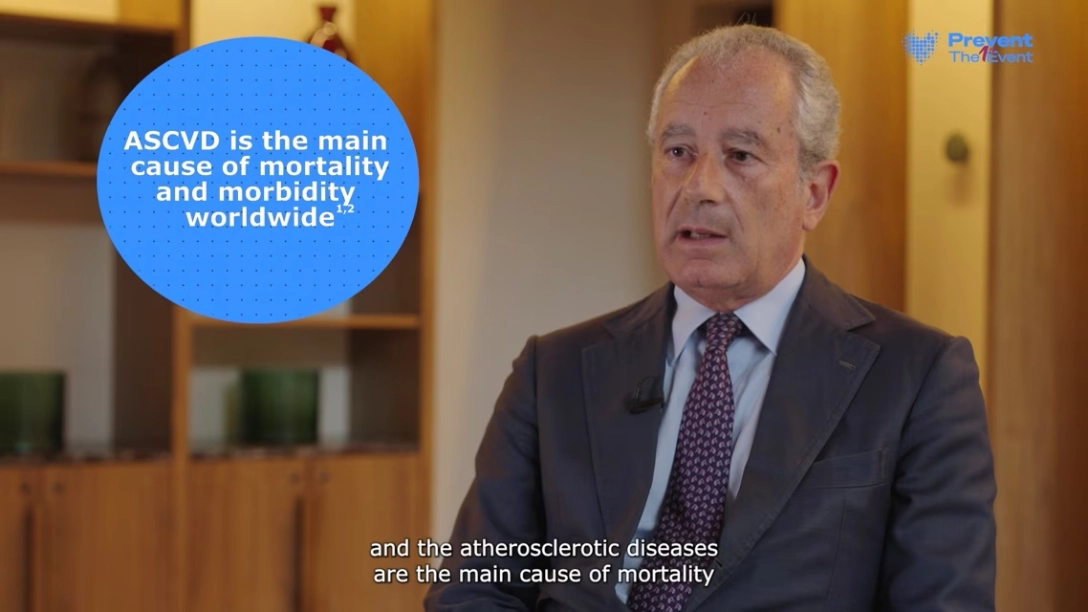Cardiovascular diseases (CVDs) are the leading cause of death globally1
According to the World Health Organization, an estimated 17.9 million people died from CVDs in 2019, representing 32% of all global deaths.1 Of these deaths, 85% were due to myocardial infarction or stroke.1 A CV event is a highly traumatic experience for patients and their families.2 It takes a heavy emotional toll, brings widespread disability and significantly impedes quality of life.3,4
The need is clear: the healthcare community must do more to prevent devastating cardiovascular events in high and very high-risk patients that cause personal, societal and economic trauma!
Reducing risk in very high-risk ASCVD patients requires a HOLISTIC APPROACH and control of all modifiable risk factors, including elevated low-density lipoprotein cholesterol (LDL-C).5
Over 4 million deaths were attributed to elevated LDL-C in 2019.6,12 That’s eight deaths per minute, and many of those could be prevented.
According to the 2019 ESC/EAS Guidelines for the management of dyslipidaemia and the 2023 ESC Guidelines for the management of CVD in patients with diabetes, all ASCVD patients without exceptions are classified as very high-risk and, as such, have very strict LDL-C targets: <1.4 mmol/L (<55 mg/dL) AND ≥50% LDL-C reduction vs. baseline.5,11
Yet, less than one third of ASCVD patients had their LDL-C levels within target range, according to the multinational observational SANTORINI study.7 The reasons behind that are numerous, with one of them certainly being underuse of lipid-lowering treatment (LLT), most notably – combined LLT in general and PCSK9 inhibitors in particular.7
Who are the at-risk patients?
Mission of the healthcare community: to help ASCVD patients avoid the trauma of a 1st event through effective LDL-C control and CV risk reduction.
ASCVD - atherosclerotic cardiovascular disease, LLT - lipid-lowering treatment, LDL-C - low density lipoprotein cholesterol, T2DM - type 2 diabetes mellitus, CAD - coronary artery disease, PAD - peripheral artery disease, TGs - triglycerides, HbA1c - glycated haemoglobin, BMI - body mass index, CTA - computed tomography angiography, PCI - percutaneous coronary intervention
Referenties
-
World Health Organization. Cardiovascular Diseases. Cardiovascular diseases (CVDs) (who.int). Last accessed July 2024
-
Princip, M., Ledermann, K. & von Känel, R. Posttraumatic Stress Disorder as a Consequence of Acute Cardiovascular Disease. Curr Cardiol Rep 25, 455–465 (2023). https://doi.org/10.1007/s11886-023-01870-1
-
Kim J. Post-stroke mood and emotional disturbances: pharmacological therapy based on mechanisms. J Stroke. 2016 Sep; 18(3): 244-255. Published online 2016 Sep 30. doi: 10.5853/jos.2016.01144
-
Mollon L, Bhattacharjee S. Health related quality of life among myocardial infarction survivors in the United States: a propensity score matched analysis. Health Qual Life Outcomes. 2017 Dec 4;15(1):235. Health related quality of life among myocardial infarction survivors in the United States: a propensity score matched analysis | Health and Quality of Life Outcomes | Full Text (biomedcentral.com)
-
Marx N et al; ESC Scientific Document Group. 2023 ESC Guidelines for the management of cardiovascular disease in patients with diabetes. Eur Heart J. 2023 Oct 14;44(39):4043-4140. 2023 ESC Guidelines for the management of cardiovascular disease in patients with diabetes - PubMed (nih.gov)
-
Mattiuzzi C, Sanchis-Gomar F, Lippi G. Worldwide burden of LDL cholesterol: Implications in cardiovascular disease. Nutr Metab Cardiovasc Dis. 2020;30(2):241-244. Worldwide burden of LDL cholesterol: Implications in cardiovascular disease - PubMed (nih.gov)
-
Ray KK, et al; SANTORINI Study Investigators. Treatment gaps in the implementation of LDL cholesterol control among high- and very high-risk patients in Europe between 2020 and 2021: the multinational observational SANTORINI study. Lancet Reg Health Eur. 2023 Apr 5;29:100624.Treatment gaps in the implementation of LDL cholesterol control among high- and very high-risk patients in Europe between 2020 and 2021: the multinational observational SANTORINI study - PubMed (nih.gov)
-
Mak KH, et al. CLARIFY Investigators. Prevalence of diabetes and impact on cardiovascular events and mortality in patients with chronic coronary syndromes, across multiple geographical regions and ethnicities. Prevalence of diabetes and impact on cardiovascular events and mortality in patients with chronic coronary syndromes, across multiple geographical regions and ethnicities - PubMed (nih.gov)
-
World Health Organization. The top 10 causes of death. 2020. https://www.who.int/news-room/fact-sheets/detail/the-top-10-causes-of-death. Accessed: July 2024;
-
Saely CH, et al. Single and combined effects of peripheral artery disease and of type 2 diabetes mellitus on the risk of cardiovascular events: A prospective cohort study. Atherosclerosis. 2018 Dec;279:32-37; Single and combined effects of peripheral artery disease and of type 2 diabetes mellitus on the risk of cardiovascular events: A prospective cohort study - PubMed (nih.gov)
-
Mach F, Baigent C, Catapano AL, Koskinas KC, Casula M, Badimon L, Chapman MJ, De Backer GG, Delgado V, Ference BA, Graham IM, Halliday A, Landmesser U, Mihaylova B, Pedersen TR, Riccardi G, Richter DJ, Sabatine MS, Taskinen MR, Tokgozoglu L, Wiklund O; ESC Scientific Document Group. 2019 ESC/EAS Guidelines for the management of dyslipidaemias: lipid modification to reduce cardiovascular risk. Eur Heart J. 2020 Jan 1;41(1):111-188. 2019 ESC/EAS Guidelines for the management of dyslipidaemias: lipid modification to reduce cardiovascular risk | European Heart Journal | Oxford Academic (oup.com). Erratum in: Eur Heart J. 2020 Nov 21;41(44):4255. 2019 ESC/EAS guidelines for the management of dyslipidaemias: Lipid modification to reduce cardiovascular risk - PubMed (nih.gov)
-
Zheng J, Wang J, Zhang Y, Xia J, Guo H, Hu H, Shan P, Li T. The Global Burden of Diseases attributed to high low-density lipoprotein cholesterol for 1990 to 2019. Front Public Health. 2022 Aug 16;10:891829. The Global Burden of Diseases attributed to high low-density lipoprotein cholesterol from 1990 to 2019 - PubMed (nih.gov)













